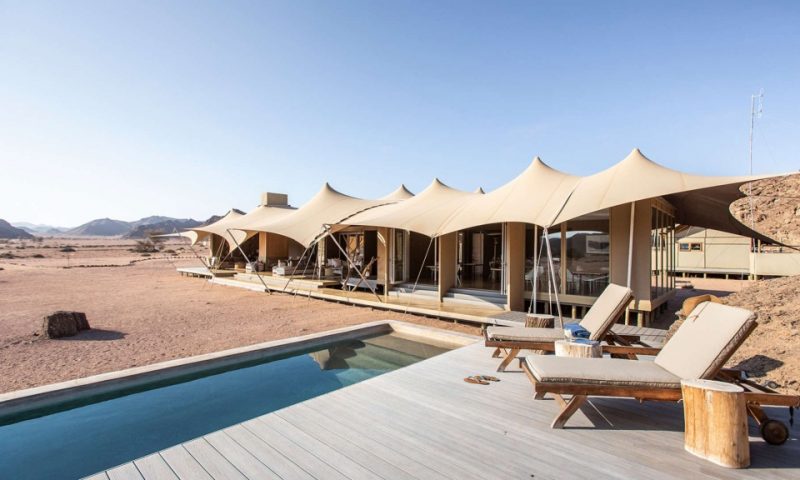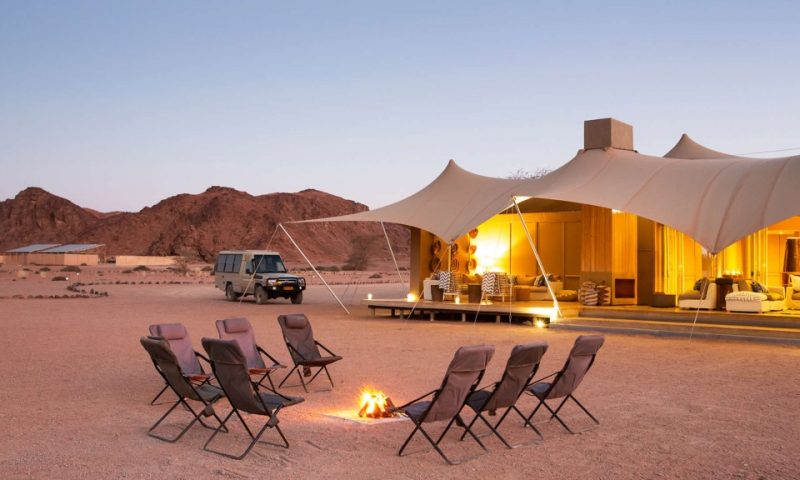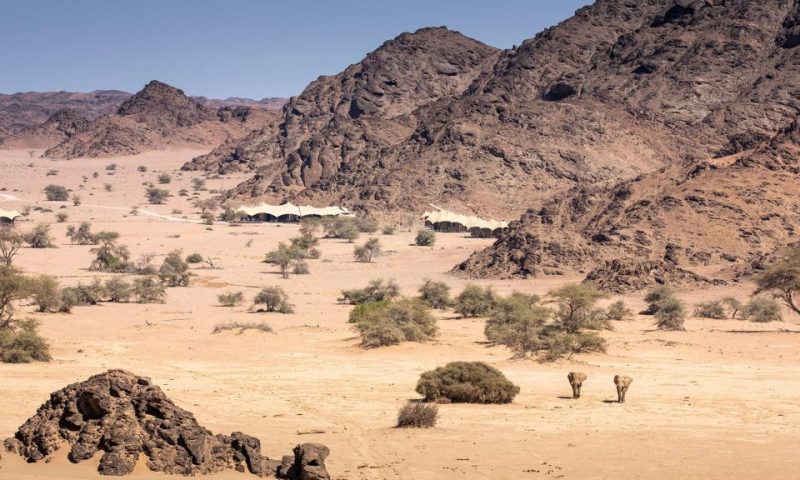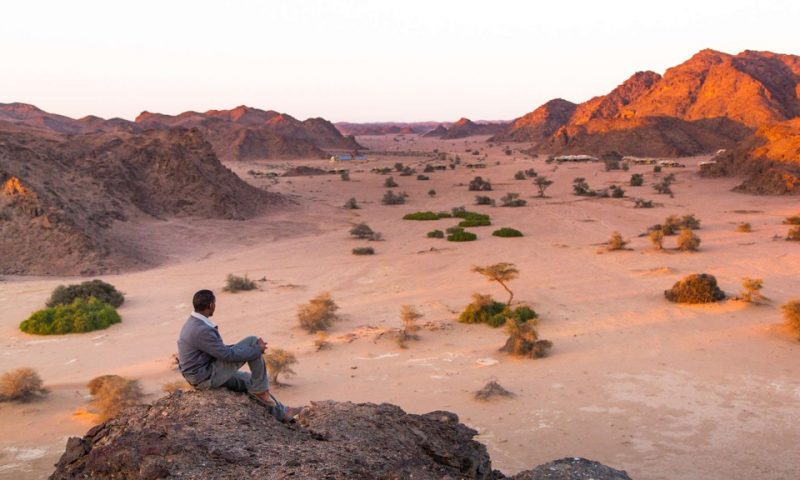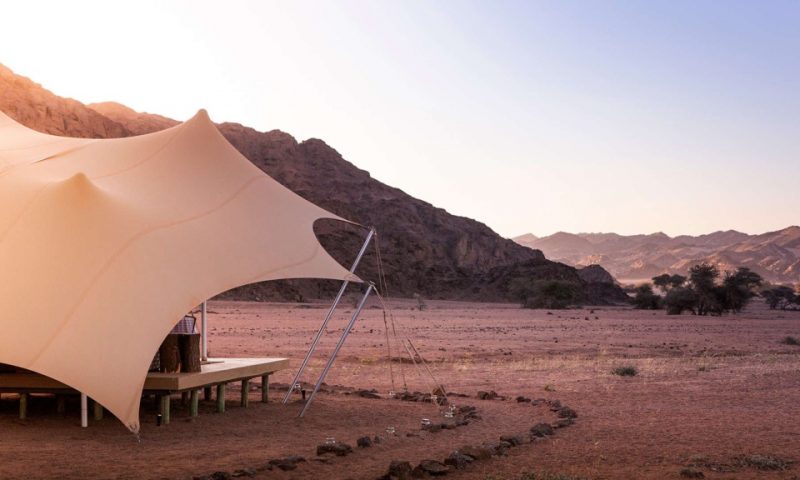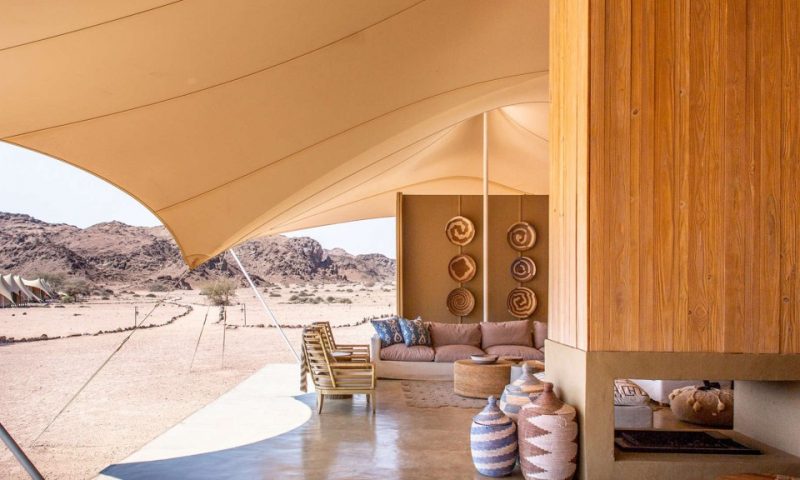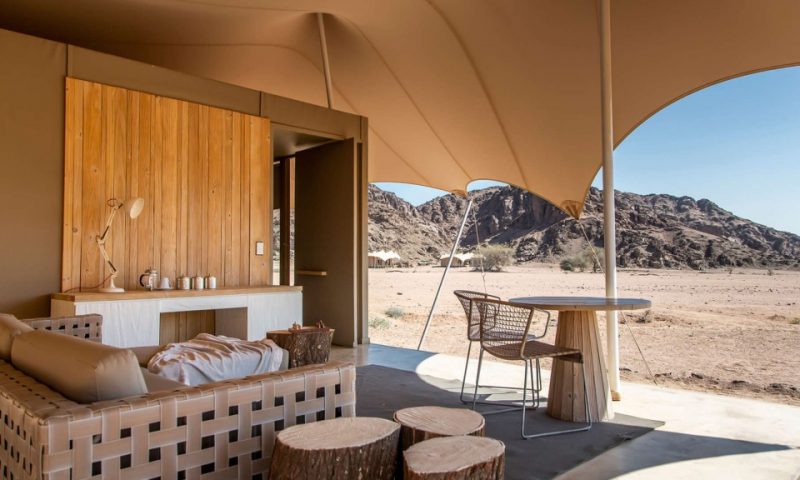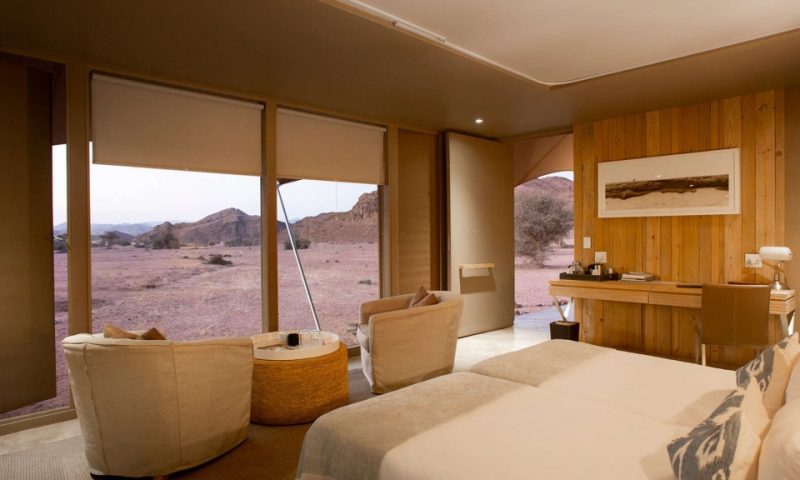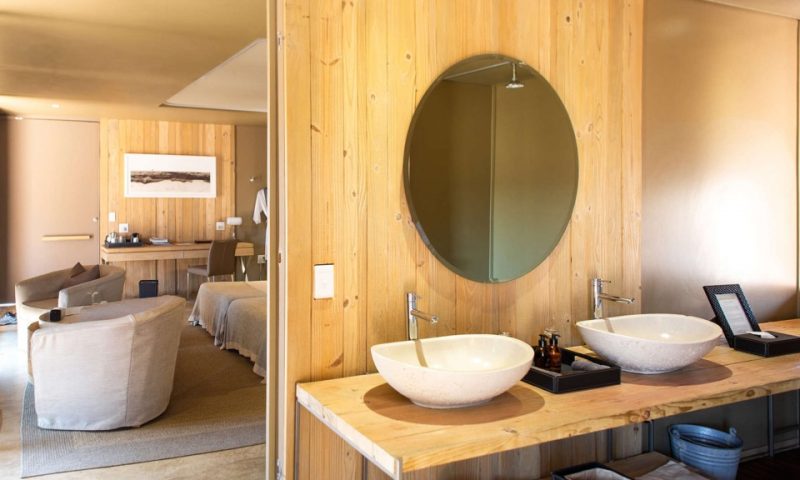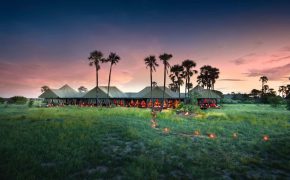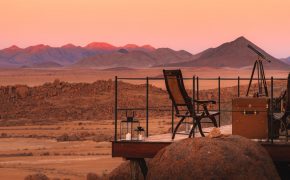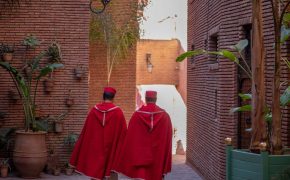In a remote area of the Kaokoveld, with gravel-strewn plains and dry riverbeds that draw fascinating wildlife, lies Hoanib Skeleton Coast Camp. Game drives explore this isolated area, moving along the riverbed’s narrow ribbon of vegetation, where a surprising wealth of desert-adapted animals can be found; in camp the research centre provides even more insights.
The unforgiving Skeleton Coast, with its shipwreck remains and noisy colonies of Cape fur seals, is accessed either by a fascinating drive or flight, depending on the weather. Eight large en-suite tents (including one family tent) and the main area and pool look out over a wide, rugged valley that slopes down to the almost-always dry Hoanib River.
Fully solar powered, Hoanib Skeleton Coast is a joint venture with the neighbouring conservancies of Anabeb, Torra and Sesfontein, and hosts researchers committed to conserving desert-adapted lion, brown hyaena and more.
WILDLIFE
Hoanib Skeleton Coast’s location – close to the Skeleton Coast and within the true Namib Desert – is home to a rich diversity of wildlife, boasting the Kaokoveld’s best viewing of desert-adapted wildlife and access to vast, remote and isolated wilderness.
Almost miraculously it seems, in this stark environment, enormous elephant thrive along with giraffe, lion and brown hyaena. Gemsbok (oryx), springbok, steenbok, scrub hare, and inquisitive ground squirrel are also seen.
Entirely different to the rugged mountains and valleys inland, the Skeleton Coast hosts Cape fur seals in their thousands along with black-backed jackals and brown hyaena.
Birds are equally diverse, with regular endemics like Rüppell’s korhaan, Benguela long-billed lark and lark-like bunting. Towards the coast, the bird community changes and tractrac chat can be seen, as well as jaegers and skuas found around the seal colonies.
PALMWAG
The remote, northern reaches of the 450 000ha (1 111 935-acre) Palmwag Concession are in stark contrast to the south. Here the landscape is dominated by the form of the Hoanib River, a swathe of sand that meanders through rocky gorges and past arid sandy plains.
The riverbed – an ephemeral linear oasis penetrating the depths of the desert – is lined with albida trees, the pods of which form the staple dry season diet of desert-adapted elephant, giraffe, gemsbok and springbok.
Lions spend the heat of the day in salvadora and salsola thickets waiting for the cool of night. The iconic oasis spring of Auses lies in the dunefield to the west and is best seen from the air en route to the gravel plains on the coast, where the fur seal colonies dwell.
NAMIBIA BIODIVERSITY
Namibia is a country of astonishing contrasts, home to the oldest desert on the planet, the white saltpans of Etosha National Park, the uninhabited beaches of the Skeleton Coast and the vast wilderness of Kaokoveld. These unique landscapes are also home to much endemic and special wildlife that are found nowhere else on Earth.
Namibia’s diversity is astounding: approximately 4 000 species of plants, over 650 bird species and 80 large mammal species, of which 604 plants, 14 birds and 15 mammals are almost entirely endemic to the country, some extending marginally into southern Angola.
Reptile species total 258 and, as is fitting for such a dry, hot place, sun-loving lizard species number 125, making this the richest lizard fauna in Africa.
Species such as Hartmann’s mountain zebra, dune lark and Peringuey’s adder are spectacular examples of species that have adapted superbly to the harsh dry environment and, together with a myriad other species, are waiting to be ‘discovered’ by our guests.
MAMMALS
Namibia’s maze of national parks, reserves and community conservancies makes up an impressive 20% of the country, providing many pristine areas for unrivalled wildlife observation.
Out of the country’s total mammal fauna of over 200 species – a diverse range from plains zebra to lion, at least 15 are currently regarded as endemic: dune hairy-footed gerbil is entirely restricted to the Namib, the rest being bats, other rodents and small carnivores.
Hartmann’s mountain zebra, Damara dik-dik, black-faced impala and the rock-loving dassie rat all have 75% or more of their population occurring solely in Namibia. However, the most unique and eye-catching must be the assemblage of arid-adapted species or subspecies found here.
These include the likes of the acclaimed ‘desert elephants’, suricates (meerkats), Cape and bateared fox, short-eared elephant-shrew, striped tree squirrel, Grant’s golden mole, secretive brown hyaena, 40% of Africa’s cheetah population, specialist antelope such as gemsbok and springbok, and the largest free-ranging population of black rhino on the continent.
Amongst the Namibian marine mammal component, bottlenose and the localised Heaviside’s (Benguela) dolphins occur year round, while southern right whale is seasonal.
BIRDS
Namibia is an excellent birding destination. The dryer interior harbours many range-restricted birds, several with distributions only marginally extending into neighbouring South Africa or Angola. The number of bird species recorded is over 650 – remarkable considering the aridity but not surprising considering the habitat diversity.
Of even more interest to visiting birders is the high rate of endemism – apart from one true endemic species, dune lark, there are close on 20 near-endemic species and a multitude of other bird species that are harder to find elsewhere in the subregion, such as Burchell’s courser.
Coastal wetlands like Walvis Bay are of international importance and host many migratory shorebirds in the African summer. The Walvis Bay Lagoon provides globally important refuge to greater and lesser flamingo as well as chestnut-banded plover.
The Namib escarpment is where the majority of Namibia’s avian specialities are found, such as Herero chat, rockrunner, Benguela long-billed lark, violet wood-hoopoe, Damara and Monteiro’s hornbill and the enigmatic white-tailed shrike.
The gravel plains adjacent to the coast are far from lifeless and careful scrutiny can produce the cryptic Gray’s lark and tractrac chat. The moist woodlands of the north-east add further avian diversity owing to the lushness of its environs. The bird checklist follows the taxonomic order of the IOC World Bird List and has been grouped by family for ease of reference.
REPTILES
Namibia is a country dominated by desert, aridity and plentiful sunlight – perfect conditions for reptiles. As a result the rate of endemism and specialisation amongst its 258 recorded reptile species is high with more than half of these species occurring nowhere else in the world.
Central and north-western Namibia are particularly rewarding and, in addition to endemism, the country is blessed with varied reptile genera, making it an exciting destination to observe these fascinating ancient creatures. Reptiles are found in abundance throughout the country from the Namib Desert to Etosha, the Skeleton Coast and the rocky plains of Damaraland.
The continuous shifting sands of the Namib are the ideal hunting ground for species such as Peringuey’s adder, shovel-snouted lizard and the beautiful, almost translucent Namib dune (web-footed) gecko.
The rocky landscape of Damaraland is just as bejewelled in colourful and interesting reptilian life: from the vivid Namib rock agama to the super-fast Kaokoveld sand lizard. Namibia’s reptilian diversity can only be described in one word: spectacular!
Taxonomically the reptiles in this checklist have been grouped and named according to ‘A Guide to the Reptiles of Southern Africa’ by Johan Marais and Graham Alexander.
AMPHIBIANS
The term ‘amphibian’ comes from the Greek – amphi: double; bios: life. This ‘double life’ refers to the two phases of life that characterise most amphibians. The first is the aquatic tadpole stage, and the second an adult terrestrial stage.
Of course the arid conditions that dominate most of Namibia (aside from the Caprivi) suggest that amphibian diversity in the country would therefore be relatively low. There are exceptions to the double life however and amphibians are experts at exploiting ephemeral conditions, meaning that no fewer than 40 species are found within the country’s borders.
Many of the species found in Namibia occur widely across the subregion, but given the extreme conditions, there are a handful that occur nowhere else on Earth and are endemic to the country – with perhaps some extension into neighbouring Angola or South Africa.
Damaraland pygmy toad, Hoesch’s pygmy toad, Dombe pygmy toad, marbled rubber frog and Damaraland sand frog all fall into this category and are exciting finds
after summer rains in the areas of north-west Namibia.
The amphibian checklist is conveniently categorised in the respective families and taxonomically follows ‘A Complete Guide to the Frogs of Southern Africa’ by Vincent Carruthers and Louis Du Preez.
TIPS FOR WILDLIFE VIEWING
- Binoculars are essential particularly for observing birds and smaller mammal species. When larger animals are spotted at a distance, binoculars will enhance the enjoyment of those particular sightings.
- Patience is a good virtue for wildlife viewing. Spend a little more time at each sighting and quietly observe fascinating behavioural traits coming to the fore.
- Early morning and late afternoon are the best times to be out looking for wildlife. This is the ‘golden hour’ for photography and animal activity peaks, with nocturnal species (e.g. leopard) often still active.
- During the heat of the day many animals will drink at waterholes (e.g. elephant, zebra), making this a good time to be there.
- Night drives (where available) can also be rewarding for nocturnal mammals such as genets, bushbabies, honey badger and brown hyaena.
- Best months for bird watching are December to April when resident birds are most active and intra-African and Palaearctic migratory species are in the subregion.
RESEARCH & CONSERVATION
Hoanib Skeleton Coast Camp is a centre for research and conservation of the desert-adapted predators of this harsh region: the desert-adapted lion and brown hyaena. The camp is also part of a joint venture partnership with the neighbouring communities, so that ecotourism is able to benefit the people of the area.
NAMIBIA DESERT LION CONSERVATION
Hoanib supports a unique population of desert-adapted lions in the surrounding harsh desert environment. The “desert” lion is a prominent feature in Namibia and is highly valued by the growing tourism industry. However, the conflict between lions and the local people is of continued concern and it is this that the project seeks to mitigate.
ECO-FRIENDLY MANAGMENT SYSTEMS
This camp is set in one of the most fragile ecosystems in the world, and therefore has been built with minimal impact on the environment. It is 100% solar powered, with each guest tent having its own small solar geyser for hot water.
We have also ensured that the design of the tents and main area maximise natural lighting, air movement and insulation. In order to reduce our use of bottled water, reverse osmosis filtration is done on site to provide guests with high-quality drinking water.
This camp is managed and monitored against very strict in-house environmental standards, so only approved eco-friendly detergents and chemicals are used. We make use of innovative eco-friendly systems to break down wastewater which can then be used by plant life.
GAME DRIVES
Nature drives showcase the magnitude of the landscape and offer the best possibilities of seeing desert-adapted wildlife. Morning or afternoon drives are available, as well as full-day excursions.
DAY TRIPS TO DESERT OASES
These oases offer an inviting respite from the dry surrounds of the desert and the chance to see wildlife coming to drink, as well as plenty of birdlife. These full-day trips are undertaken in our semi-closed game drive vehicles, with a stop for a picnic at a scenic spot along the way.
BIRDING
Birding enthusiasts are sure to enjoy the diverse avifauna of the northern Palmwag Concession, from soaring raptors to charming Namaqua sandgrouse and other regular endemics, including Rüppell’s korhaan and Benguela long-billed lark.
EXPLORE THE DUNES
Nature walks from camp take in the magnificent surrounds as well as offer a glimpse at vestiges of the Strandloper (Beachcomber) lifestyle from hundreds of years ago. It is also a good opportunity to study the smaller creatures and the fascinating plant life of the concession.
INTERACTION WITH WILDLIFE RESEARCHERS
At the Hoanib Research Centre, presentations by, and interactions with, wildlife researchers are possible when they are in camp. These cover all current research being supported at Hoanib, in particular the vital work conducted by Dr Philip Stander and his team studying the unique desert-adapted lion.
SKELETON COAST EXCURSION
On a stay of three or more nights, full-day excursions to the Skeleton Coast are offered. The fascinating 4×4 trip to the coast takes you via the wilderness of the Hoanib River and floodplain, the dune fields and Klein Oasis, while the Skeleton Coast itself reveals huge Cape fur seal colonies and shipwreck remains. Weather-dependent, a flight back to camp can offer a magnificent perspective of your journey from the air.
